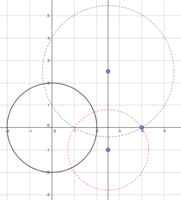You are using an out of date browser. It may not display this or other websites correctly.
You should upgrade or use an alternative browser.
You should upgrade or use an alternative browser.
Circles - does this question have missing info?
- Thread starter yobacul
- Start date
Dr.Peterson
Elite Member
- Joined
- Nov 12, 2017
- Messages
- 16,605
It looks like you have done good work, and you found that there is no was to determine y. So it looks like y can be anything!
Check that out: Either construct the figure as I did with y arbitrary and see that the resulting circle will always meet the requirements, or just try some specific values of y and see what happens.
So the problem is faulty, in the sense that "the" is inappropriate (or additional information would be needed to make it so). There are infinitely many solutions.
Check that out: Either construct the figure as I did with y arbitrary and see that the resulting circle will always meet the requirements, or just try some specific values of y and see what happens.
So the problem is faulty, in the sense that "the" is inappropriate (or additional information would be needed to make it so). There are infinitely many solutions.
topsquark
Senior Member
- Joined
- Aug 27, 2012
- Messages
- 2,307
This is just a check for me. What does it mean when you say that the circles are orthogonal? Does it mean that for the two points that the circles intersect their slopes are perpendicular?View attachment 19950
Does this question have weird or missing information? I got the centre of the circle to have coordinate (2.5, ?) Cannot find the other one.
Thanks in advance
Thanks.
-Dan
Dr.Peterson
Elite Member
- Joined
- Nov 12, 2017
- Messages
- 16,605
Yes: https://mathworld.wolfram.com/OrthogonalCurves.htmlThis is just a check for me. What does it mean when you say that the circles are orthogonal? Does it mean that for the two points that the circles intersect their slopes are perpendicular?
Thanks.
-Dan
M
Thanks a million. I thought I was doing something wrong ... thanks for clarifying it. Much appreciated.
It looks like you have done good work, and you found that there is no was to determine y. So it looks like y can be anything!
Check that out: Either construct the figure as I did with y arbitrary and see that the resulting circle will always meet the requirements, or just try some specific values of y and see what happens.
So the problem is faulty, in the sense that "the" is inappropriate (or additional information would be needed to make it so). There are infinitely many solutions.
Thanks a million. I thought I was doing something wrong ... thanks for clarifying it. Much appreciated.
pka
Elite Member
- Joined
- Jan 29, 2005
- Messages
- 11,975
Oh, come on. Draw a picture. Two circles are orthogonal if and only if the circles share one point.View attachment 19950
Does this question have weird or missing information? I got the centre of the circle to have coordinate (2.5, ?) Cannot find the other one.
The given circle has radius \(2\) and center \((0,0)\). The required circle is \((x-3)^2+y^2=1\) The point of orthogonality is \((2,0)\).
SEE HERE
Dr.Peterson
Elite Member
- Joined
- Nov 12, 2017
- Messages
- 16,605
That's tangent, not orthogonal.Oh, come on. Draw a picture. Two circles are orthogonal if and only if the circles share one point.
The given circle has radius \(2\) and center \((0,0)\). The required circle is \((x-3)^2+y^2=1\) The point of orthogonality is \((2,0)\).
SEE HERE
Here are two of the infinitely many solutions:

Oh, come on. You don’t know the definition of orthogonality mate! Thanks anywayOh, come on. Draw a picture. Two circles are orthogonal if and only if the circles share one point.
The given circle has radius \(2\) and center \((0,0)\). The required circle is \((x-3)^2+y^2=1\) The point of orthogonality is \((2,0)\).
SEE HERE
Yes the center of the circle lies on x=5/2. Thanks againThat's tangent, not orthogonal.
Here are two of the infinitely many solutions:
View attachment 19960
